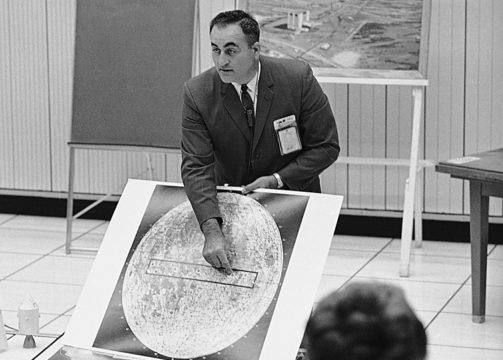
Sasso di Castalda is a town in the province of Potenza (Basilicata), known above all for its double Tibetan bridge, the "Ponte alla Luna". From here, in 1921, Antonio Petrone and his wife Teresa DeLuca left for America, moving away from the south despite the work of Antonio, a member of the Carabinieri, with the awareness that they wanted to offer a better future to their children who would arrive soon.
The town of Amsterdam has developed along the river Mohawk, which joins the Hudson near New York, and is part of the Montgomery County: here arrived and settled the Petrones, and Antonio found a job in the construction sites of the railway.
On March 31, 1926, a son was born and they gave him the name of Rocco Anthony. Six months later his father Antonio lost his life in an accident at work and Teresa respected the wishes of both, staying in the States and managing to grow up and have the little Rocco studying.
Fastforwarding we find Rocco Petrone in the Catholic schools, where he alternates profitable study with a decent sporting activity, standing out in the defensive roles of football thanks to his physical performance and determination. The strength of will and attitude allows Rocco to pass the tough selections for admission to the Army Academy of West Point.
In the famous institution that formed the officers of one of the most important military forces in the world, Petrone also entered the ranks of the Cadets (now Black Knights), the Army football team. In 1944-1945-1946, the team was awarded three times the title of national champion of college football. In Army's long history it had only happened twice more, in 1914 and 1916.
Two stars shone in the team: fullback Felix Doc Blanchard and halfback Glenn Davies, Mister Inside and Mister Outside, both awarded the Heisman Trophy as the country's best college players in 1945 and 1946 respectively. The team, led by coach Earl Red Blaik and captained by the paisa Tom Lombardo (who was killed in combat in 1950 in Korea), closed with a record of 9 victories and no defeats both in 1944 and 1945. The press celebrated those victories: 69-7 against Pittsburgh, 59-0 against Notre Dame, 62-7 against Penn (1944) and 54-0 against Wake Forest, 54-0 against Villanova, 61-0 against Penn and 32-13 against Navy (1945).
A real "war machine" that will record a long winning streak (27 consecutive wins) and a record, from 1944 to 1950, of 57 victories, 3 defeats and 4 draws. In this superteam (the Army had attracted to West Point many of the best athletes from all over the States) Rocco Petrone had played the role of defensive tackle with good results (back in those days the Italian Americans were used more than anything else in the role of kicker!). Besides, although not included in the roster of the starters, Rocco was often put in the field by the coach at certain times of the game and the tracks can be found in the newspapers of the time.
A curious note: in his résumé he mentions a degree at West Point while in Army's media guides he doesn't appear in the all-time list of lettermen; perhaps this can be explained by the fact that Petrone was sent for service in West Germany from 1947 to 1950, to return to the USA and resume his studies in 1951 at MIT (Massachusetts Institute of Technology), where he will get a master's degree in mechanical engineering.
Rocco will remain in the army until 1960 with the rank of lieutenant colonel, participating in the development of the Redstone missiles, before moving to NASA, where he will begin another chapter of his life that will take him really far.
His activity in the space agency will go through the development of Saturn, before landing at the Apollo project, succeeding Werner Von Braun and Eberhard Rees as the Director of the Marshall Space Flight Center. From the command console of the "fire room" next to Von Braun, it will be Rocco Anthony Petrone who will pronounce the countdown and give the "3,2,1...go!" to the Apollo 11 mission, at 9.32 am on July 16, 1969.
Millions of viewers in front of the black and white TV screen were able to watch the launch and then, on July 21, to follow the first steps of a man on the Moon. Standing in front of a brand Atlantic television (very Italian...) I was there, too. During the mission, Neil Armstrong set foot on the lunar surface and then, together with Buzz Aldrin, carried out an extra-vehicular activity on the lunar surface for 2 and a half hours, while the third member of the crew, Michael Collins, had been waiting on the command module in orbit around the Moon.
In an interview Petrone, the "Tiger of Cape Canaveral", declared: "When my son asked me why I was always absent, I told him about man's great achievements and the extraordinary privilege that he and millions of people around the world would have in witnessing the conquest of the Moon. I was suffering by being far from my family, but I never had any doubts. In eight years of preparation, from Saturn rockets to the first launches of Apollo, I have accumulated more technological experience than a normal person does in a lifetime. And I got to the appointment sure that I could count on an exceptional team.”
A report for an in-depth look at the NASA period: the RAI journalist Renato Cantore, who told the story of Rocco Petrone in the 2009 book "The Tiger and the Moon", is preparing a new expanded edition, enriched also thanks to the opening of the archives of the space agency, whose release is scheduled for next June.



